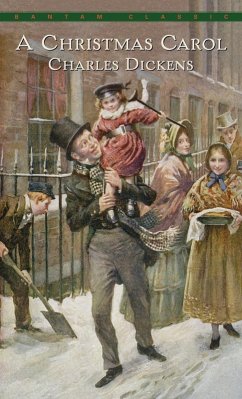"Bah Humbug!" That's how Ebeneezer Scrooge feels about Christmas--until the Ghosts of Christmas Past, Present, and Future decide to show the crotchety old miser the error of his ways. Together they travel through time, revisiting all the people who have played an important role in Scrooge's life. And as their journey concludes, Scrooge is reminded of what it means to have love in his heart, and what the true spirit of Christmas is all about. A timeless story the whole family will enjoy!
Dieser Download kann aus rechtlichen Gründen nur mit Rechnungsadresse in A, B, BG, CY, CZ, D, DK, EW, E, FIN, F, GR, HR, H, IRL, I, LT, L, LR, M, NL, PL, P, R, S, SLO, SK ausgeliefert werden.

Der Dickens-Klassiker in neuem Gewand
Scrooge heißt der Mann, der von Weihnachen so gar nichts wissen will. Sein Leben erschöpft sich im Nachrechnen des Kontostandes, er ist der verkörperte puritanisch-kapitalistische Geist Englands - und Charles Dickens erweckt für den Leser eine ältere, vorreformatorische Welt wieder; eine, in der man überschwänglich und "irrational" feierte, in der man noch anderes kannte als die Bilanz.
Deshalb ist seine Weihnachtsgeschichte zum Klassiker der Moderne geworden. Denn mit Weihnachten kommt alljährlich aufs Neue etwas anderes, eine Unterbrechung des Betriebs. In das Gemisch von ewigem Londoner Nebel und zeitgenössischen Industriedämpfen lässt Dickens ein Licht strahlen, das mit der Geburt des Erlösers in die Welt trat. Vielleicht haben ja alle Dickens-Romane etwas von einem herzerwärmenden Weihnachtsmärchen, weil sie einer Gerechtigkeitsidee folgen, die uns zuweilen naiv erscheinen mag. Abwechslungsreich in den Formaten und kühn in den Perspektiven hat P. J. Lynch das Buch illustriert.
Nur in einem Punkt muss man die Begeisterung einschränken: Kinder unter zwölf Jahren dürften von einer Geschichte überfordert sein, in der Hamlets Vater, die Börse und das britische Testamentsrecht vorkommen. Natürlich kann ein Vorleser diese Stellen überspielen - aber alles hat seine Zeit, und an die Stelle überzogener Bildungshuberei (ist sie nicht ihrerseits von gegenwärtig-kapitalistischem, erfolgssüchtigem Geist, den man an den Nachwuchs delegiert?), die schon die ganz Kleinen mit dem Kanon befrachten will, sollte eine realistische Beurteilung der kindlichen Aufnahmefähigkeit treten.
LORENZ JÄGER
Charles Dickens: "Eine Weihnachtsgeschichte". Aus dem Englischen übersetzt von Curt Noch. Mit Illustrationen von P. J. Lynch. Cecilie Dreßler Verlag, Hamburg 2007. 160 S., geb., 19,90 [Euro].
Ab 12 J.
Alle Rechte vorbehalten. © F.A.Z. GmbH, Frankfurt am Main

